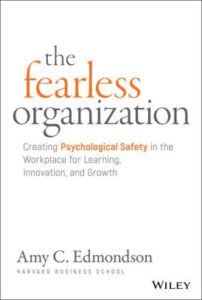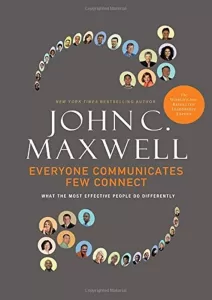Book Review: “The Fearless Organization”
Book: The Fearless Organization by Amy Edmondson
Reviewer: Bobby Powers
My Thoughts: 8 of 10
Harvard Business School professor Amy Edmondson stumbled upon the concept of "psychological safety" while she was researching teamwork. She eventually realized that psychological safety is one of the biggest drivers of team success, and her research is now cited in hundreds of business books and articles. Most books written by academics are dry and boring. Thankfully, this one is not. Edmondson includes enough stories and case studies to appease business readers and executives while including enough research and data to appease academics--a tough line to walk. This is an important and practical book meant for all leaders.
What I Learned from the Book
No matter how much organizations try to empower employees and resist top-down hierarchical thinking, it's difficult to dismantle power dynamics. Many employees are scared to give feedback or challenge the ideas of their superiors, especially when their manager has an outsized ego. But when employees don't share their knowledge and ideas, companies often end up with horrible decisions fueled by empty head nods and false consensus. Teams can counter that problem by improving psychological safety--encouraging everyone to share their ideas freely and engage in productive disagreement.
Selected Quotes and Ideas from the Book
Psychological Safety
- "Psychological safety is broadly defined as a climate in which people are comfortable expressing and being themselves. More specifically, when people have psychological safety at work, they feel comfortable sharing concerns and mistakes without fear of embarrassment or retribution. They are confident that they can speak up and won't be humiliated, ignored, or blamed."
- "In psychologically safe workplaces, people know they might fail, they might receive performance feedback that says they're not meeting expectations, and they might lose their jobs due to changes in the industry environment or even to a lack of competence in their role. These attributes of the modern workplace are unlikely to disappear anytime soon. But in a psychologically safe workplace, people are not hindered by interpersonal fear. They feel willing and able to take the inherent interpersonal risks of candor. They fear holding back their full participation more than they fear sharing a potentially sensitive, threatening, or wrong idea."
- "If leaders want to unleash individual and collective talent, they must foster a psychologically safe climate where employees feel free to contribute ideas, share information, and report mistakes."
- "Working in a psychologically safe environment does not mean that people always agree with one another for the sake of being nice. It also does not mean that people offer unequivocal praise or unconditional support for everything you have to say. In fac,t you could say it's the opposite. Psychological safety is about candor, about making it possible for productive disagreement and free exchange of ideas."
The Importance of Psychological Safety
- Google conducted a five-year study called "Project Aristotle" to find out what characteristics made the best teams such high performers. "They concluded, 'psychological safety was far and away the most important of the five dynamics we found.' Other behaviors were also important, such as setting clear goals and reinforcing mutual accountability, but unless team members felt psychologically safe, the other behaviors were insufficient."
- "In one study investigating employee experiences with speaking up, 85% of respondents reported at least one occasion when they felt unable to raise a concern with their bosses, even though they believed the issue was important."
- "Cheating and covering up are natural by-products of a top-down culture that does not accept 'no' or 'it can't be done' for an answer."
- "The free exchange of ideas, concerns or questions is routinely hindered by interpersonal fear far more often than most managers realize. This kind of fear cannot be directly seen."
- "When people don't speak up, the organization's ability to innovate and grow is threatened."
- A study by Hannes Leroy found that "psychologically safe teams made fewer errors and spoke up about them more often."
Other Insights
- "The data are consistent in this simple but interesting finding: psychological safety seems to 'live' at the level of the group. In other words, in the organization where you work, it's likely that different groups have different interpersonal experiences; in some, it may be easy to speak up and bring your full self to work. In others, speaking up might be experienced as a last resort...That's because psychological safety is very much shaped by local leaders."
- "[M]any managers--both consciously and not--still believe in the power of fear to motivate...But for jobs where learning or collaboration is required for success, fear is not an effective motivator. Brain science has amply demonstrated that fear inhibits learning and cooperation...Fear inhibits learning. Research in neuroscience shows that fear consumes physiologic resources, diverting them from parts of the brain that manage working memory and process new information."
- "Leaders who welcome only good news create fear that blocks them from hearing the truth."
- "Exhorting people to speak up because it's the right thing to do relies on an ethical argument but is not a strategy for ensuring good outcomes. Insisting on acts of courage puts the onus on individuals without creating the conditions where the expectation is likely to be met. For speaking up to become routine, psychological safety--and expectations about speaking up--must become institutionalized and systematized."
How to Create Psychological Safety
- Leaders should set the tone by admitting fallibility and encouraging feedback.
- When employees share feedback, listen intently and don't shut them down. "A productive response must be appreciative, respectful, and offer a path forward."
- "Emphasize purpose. Identify what's at stake, why it matters, and for whom."
- Speak about errors in a way that invites curiosity about how the team can improve. Blame and shaming make people clam up, whereas genuine curiosity and desire to improve can encourage people to share their observations.
- Example: One hospital COO trying to increase patient safety reframed the question she asked nurses each week. Rather than asking something like "What mistakes did our team make this week?", she began asking, "Was everything as safe as you would like it to have been this week with your patients?" Edmondson writes, "The question--genuine, curious, direct--was respectful and concrete: 'this week,' 'your patients.' Its very wording conveys genuine interest. Curiosity. It makes you think...[S]he invited people to think in aspirational terms."
- Introduce systems of "blameless reporting" where employees can file confidential reports about system failures if they don't feel comfortable speaking up in person.
- Reframe failure as a mechanism for learning.
- Celebrate "intelligent failures"--situations in which someone acted in good faith and sound judgment, but the outcome didn't turn out as expected.
- "The bottom line is that no one wants to take the interpersonal risk of imposing ideas when the boss appears to think he or she knows everything. A learning mindset, which blends humility and curiosity, mitigates this risk. A learning mindset recognizes that there is always more to learn."
- "In sum, leaders who are approachable and accessible, acknowledge their fallibility, and proactively invite input from others can do much to establish and enhance psychological safety in their organizations."
Think you’d like this book?
Other books you may enjoy:
Black Box Thinking by Matthew Syed
Creativity, Inc. by Ed Catmull with Amy Wallace
Fierce Conversations by Susan Scott
Other notable books by the author:
Teaming by Amy Edmondson
Teaming to Innovate by Amy Edmondson
Extreme Teaming by Amy Edmondson and Jean-François Harvey





